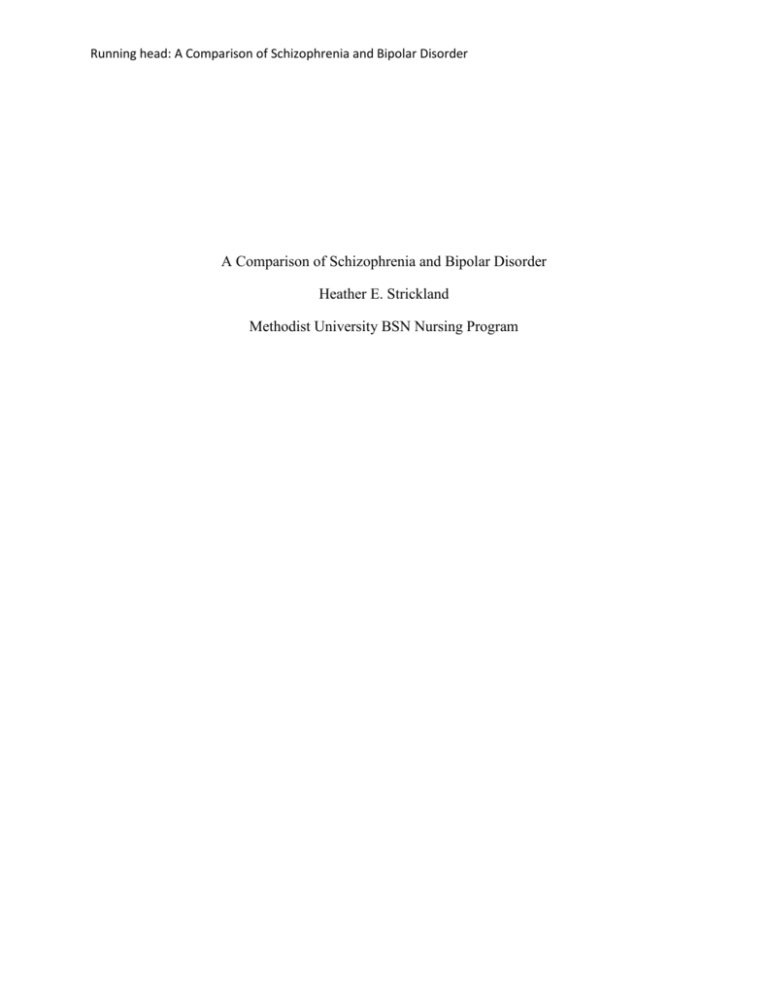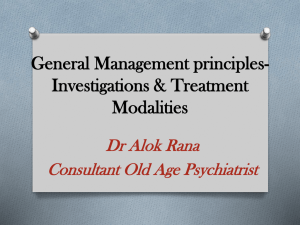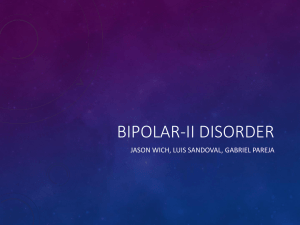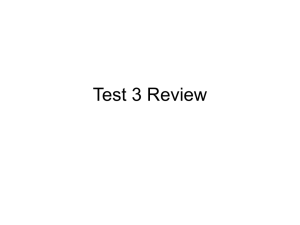File - Heather Strickland
advertisement

Running head: A Comparison of Schizophrenia and Bipolar Disorder A Comparison of Schizophrenia and Bipolar Disorder Heather E. Strickland Methodist University BSN Nursing Program A Comparison of Schizophrenia and Bipolar Disorder 2 A Comparison of Schizophrenia and Bipolar Disorder The specific similarities and differences of psychiatric mental disorders are not common knowledge to the majority of the population. Psychiatric mental disorders are defined alphabetically in the Diagnostic and Statistical Manual of Mental Disorders, which is published by the American Psychiatric Association. This manual provides one has the opportunity to view and distinguish between mental disorders that share similarities. Two common psychiatric disorders are schizophrenia and bipolar disorder. This paper presents a comparison of the etiology, signs and symptoms, treatment, and nursing care of bipolar disorder and schizophrenia. Etiology Schizophrenia and bipolar disorder are most commonly caused by genetics. The likelihood of diagnosis with one of the listed mental disorders is greatly increased if an individual has a first degree relative with the same mental disorder. The genetic connection has yielded interest in gene specific studies that connect genes with a larger likelihood of diagnosis with schizophrenia or bipolar disorder later in life. A study done by Dr. Victoria E. Cosgrove, who is an Instructor in Psychiatry and Behavioral Sciences at the Stanford University School of Medicine, and Dr. Trisha Suppes, who is the Director of the Bipolar Disorders and Depression Research Program at the VA Palo Alto Health Care System, looked into the genetic connection. Cosgrove and Suppes (2013) used both single-gene association and genome-wide association studies. In the study, two risk genes have been identified as critical and common to psychosis in both disorders and are described as follows: A Comparison of Schizophrenia and Bipolar Disorder 3 First, an intron of zinc finger binding protein 804A on chromosome 6, a protein sequence potentially involved in brain connectivity, has been implicated. Second, an intron of the L-type voltage dependent calcium channel alpha 1C subunit, potentially involved in neuronal calcium dependent processes, has also repeatedly been identified as a gene conferring a detectable increased risk in both schizophrenia and bipolar disorder. (4) Therefore, genetic susceptibility has been proven as a major risk factor for diagnosis with either schizophrenia or bipolar disorder. In addition, environmental factors can interact with genetic predisposition to trigger onset of symptoms; these factors include death in the family, alcohol or drug abuse, and moving to a new city. Signs and Symptoms There are similarities in symptoms between schizophrenia and bipolar disorder just as there is similarity in genetic factors which make a person more susceptible to both mental disorders being discussed. Fernandes et al. (2013) explains a major symptom that manifests in both mental disorders. “In both disorders, impairments of cognitive function are often observed, which play major roles in the intellectual and social dysfunction of patients” (2). Patients experience impaired insight and judgment while in the mania stage of bipolar disorder or while experiencing an episode of schizophrenia. The main concern during impaired cognitive function is the safety of the individual affected by the mental disorder, and of those in the area of that individual. While cognitive impairment is a similarity, the cause of impaired judgment varies depending on the mental disorder that is being discussed. Bipolar disorder is prominently characterized by alternating stages of mania and depression. It is during the mania stage that the individual’s judgment is the most impaired. According to Sheila Videbeck (2011), the author of Psychiatric Mental Health Nursing, the A Comparison of Schizophrenia and Bipolar Disorder 4 manic stage is defined as “at least one week of unusual incessantly heightened, grandiose, or agitated mood in addition to three or more of the following symptoms: exaggerated self-esteem, sleeplessness, pressured speech, flight of ideas, distractibility, and increased activities involving poor judgment and severe consequences” (p.299). The manic stage is followed by a depressed state, which includes symptoms such as suicidal ideation, slowed mental process, feelings of hopelessness, and anhedonia. Similar to the way symptoms of bipolar disorder are categorized in two different stages, manic and depression, schizophrenia has two categories of symptoms. The two categories are positive and negative symptoms. The symptoms that are put into the positive category are delusions, hallucinations, and disorganized thinking, speech, and behavior. The symptoms that are put into the negative category are flat affect, lack of volition, and social withdrawal or discomfort (Videbeck, 2011, p.252). Treatment For both schizophrenia and bipolar disorder, the main course of treatment is through psychopharmacology. The treatment with medication of both mental disorders is focused on one sole purpose, which is to minimize the symptoms. However, the actual drugs used for each disorder are different. The two main forms of medication used to treat bipolar disorder are lithium, an antimanic agent, and anticonvulsants, which are used as mood stabilizers. Lithium has had a high success rate in treating bipolar disorder, with the response rate reaching between 70-80% successful (Videbeck, 2011, p. 301). Lithium was once thought to only help treat the manic stage of depression, but has recently been proven to also halt the disorder from cycling into depression. A Comparison of Schizophrenia and Bipolar Disorder 5 For those who do not respond to lithium therapy, which is about 25%, anticonvulsants are used. Although these medications are primarily used to prevent seizures, they have been proven to raise the brain’s threshold for dealing with stimulation, which prevents the individual from receiving too much information at once, and avoids triggering a manic or depressive state (Videbeck, 2011, p. 302). An example of an anticonvulsant drug that is commonly used in treating bipolar disorder is Carbamazepine (Tegretol). In contrast, antipsychotic medications are used when treating schizophrenia. There are two main categories of antipsychotics, conventional antipsychotics and atypical antipsychotics. Conventional antipsychotics are dopamine antagonists, while atypical antipsychotics are dopamine and serotonin antagonists. Conventional antipsychotics were the first antipsychotics created and include drugs such as Chlorpromazine (Thorazine) and Haloperidol (Haldol). These drugs target the positive symptoms of schizophrenia such as delusions and hallucinations, but have no effect on the negative symptoms. However, atypical antipsychotic such as Clozapine (Clozaril) and Risperidone (Risperidal) successfully treat both positive and negative symptoms of schizophrenia (Videbeck, 2011, p. 256). Therefore, the first line of treatment for schizophrenia is atypical antipsychotic therapy. Nursing Care Appropriate nursing care is a vital aspect in providing successful treatment to a patient with either bipolar disorder or schizophrenia. Nursing care for patients in the manic stage of bipolar disorder or schizophrenia is similar because both conditions involve impaired insight and judgment. The first priority for nursing care for a patient with either disorder is safety. Therefore, creating a safe environment is a priority. It is also important to explain procedures before doing them in simple sentences that are easy to understand since the patient has an altered thought A Comparison of Schizophrenia and Bipolar Disorder 6 process. The nurse should also provide consistent limits for the client to provide a secure structure and environment. Lastly, it is important to give positive feedback for the client’s successes to enhance the client’s sense of well-being. The nursing care for a client in the depression stage of bipolar is slightly different from the care for the manic stage or schizophrenia. The primary concern with a client experiencing depression is suicidal ideation. Therefore, the nurse should assess the client’s potential for suicide frequently. A depressed client may not communicate if the nurse is talking too much. Therapeutic communication skills such as silence and active listening are more effective because these techniques let the client know that the nurse is listening and that the nurse thinks what the client has to say is important. Lastly, the nurse should not belittle the client’s feelings. The nurse must accept the client’s feelings and offer support for expression of emotion. Belittling the client’s feelings could prove detrimental to successful therapy (Videbeck, 2011, p. 292). Conclusion All in all, bipolar disorder and schizophrenia share similarities such as genetic predisposition and environmental factors triggering the onset of disease symptoms. Also, impaired judgment is a symptom common between both mental disorders. Nursing care of schizophrenia and bipolar disorder have both similarities and differences, with the major similarity being the need to ensure safety of the client. Both mental disorders’ main course of treatment is through psychopharmacology. However, class of drug that is used for each disorder varies based on successful treatment of symptoms. Schizophrenia and bipolar disorder can have detrimental effects on an individual’s life if not treated. However, with proper treatment and nursing care, an individual with either disease can live a successful life. A Comparison of Schizophrenia and Bipolar Disorder 7 References Cosgrove, V. E., & Suppes, T. (2013). Informing DSM-5: Biological boundaries between bipolar I disorder, schizoaffective disorder, and schizophrenia. BMC Medicine, 11(1), 1-7. doi:10.1186/1741-7015-11-127 Fernandes, C. D., Christoforou, A., Giddaluru, S., Ersland, K. M., Djurovic, S., Mattheisen, M., & ... Le Hellard, S. (2013). A genetic deconstruction of neurocognitive traits in schizophrenia and bipolar disorder. Plos ONE, 8(12), 1-9. doi:10.1371/journal. pone.0081052 Videbeck, S. (2011). Psychiatric-Mental Health Nursing ( ed.). Philadelphia : Wolters Kluwer Health Lippincott Williams & Wilkins.









